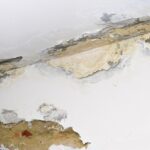While it’s true that ridding your residence of a garden is the best way to save money on water, the whole endeavor can take months (when you include the planning phase) and will definitely cost you a lot. It’s also worth mentioning that this move will be more detrimental than beneficial to you; gardens add an air of serenity in a residence.
That said, you are better off implementing any of the following water-saving measures below.
How to Save Water in the Kitchen
A lot of water is used in the kitchen. For this reason, it’s important that, in parts of the kitchen where water is used, labels are placed.
Food scraps need to be placed in a garbage pail, not rinsed down the kitchen sink, and once all the food scraps have been disposed, find a source of lukewarm water and use it to do your dishes. If you are unable to find a source of lukewarm water, you can let the dishwasher warm up. While waiting, refill ice cube trays, reusable bottles, and even your pet’s water bowl with the cooler stream.
Need hot water for another chore? Fill up a kettle with the cooler water stream, then get your rubber gloves ready since the kettle will become really hot in just a few minutes. You can toss in a few ice cubes you no longer need for more hot water.
Speaking of leftover ice cubes, you can toss them out to the plants in your garden. This way, you save water and waste no ice cubes (and waste water as a result) as you grow healthy and beautiful plants.
Leaks also cause water to end up wasted. So make sure that even the smallest leaks are fixed by a plumber as soon as they are found. Common signs of leaks include pooling water, dripping sounds, damp spots, and mold growth.
The installation of aerators and low-flow taps is another way to save water in the kitchen. These fixtures allow you to enjoy the benefits of high water pressure but without consuming unnecessary amounts of water.
Saving Water in Your Laundry Room
Wait until you have many articles of clothing to wash before you wash clothes. However, if waiting for a full load isn’t practical, then adjust load-size control.
It’s also important to check the age or at least recall when the washing machine was purchased. If you believe the unit in your home to be more than ten years old, know that they aren’t as water-efficient as newer units. As such, you may want to switch to a recent model. If switching to a recent washing machine model is impossible at the moment, then head to the nearest laundry shop when it’s time for your clothes to be washed.
Saving Water in Your Bathroom
While your shower is still warming up, position a bucket that will collect the cooler water. Use the cooler water to water plants or fill the toilet tank. You can also bathe in the colder water as you wait for it to warm up.
If you’ve decided to wait for the water to warm up, and the water has already warmed up, go for the five-minute shower or bath. Remember that it takes time for water in the shower to become warm enough, but this will warm it up more quickly.
Hot teakettle water that’s combined with water straight from the tap is great for washing your face before bedtime. And if you’ve decided to shave afterwards, make sure you don’t leave water running while doing this.
Currently have a tankless water heater but would like to make sure they don’t overheat as much? Check out tankless.reviews.
Saving Water in Your Yard
Consider using rainwater to grow all the plants in your garden. There are two ways to go about this: wait for rain to come, and collect the rain that falls. When it comes to collecting rain, you can place a barrel under a downspout, or you can build a complete rainwater harvesting system. More ideas on how to save water in the garden can be found here.
Related Posts

Loves home. I am here to provide how to make your home a much better place. 🙂 Blogging about HomeDecor, Home Improvements and more.











